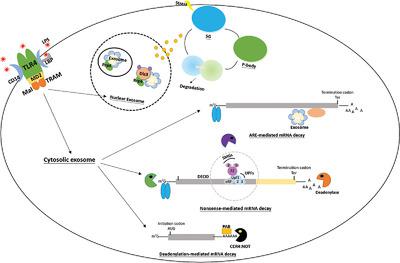当前位置:
X-MOL 学术
›
J. Leukoc. Biol.
›
论文详情
Our official English website, www.x-mol.net, welcomes your
feedback! (Note: you will need to create a separate account there.)
Regulation of RNA degradation pathways during the lipopolysaccharide response in Macrophages
Journal of Leukocyte Biology ( IF 3.6 ) Pub Date : 2020-08-23 , DOI: 10.1002/jlb.2ab0420-151rr Hui-Chi Lai 1, 2 , Alexander James 1 , John Luff 3 , Paul De Souza 1, 4, 5 , Hazel Quek 6 , Uda Ho 7 , Martin F Lavin 3 , Tara L Roberts 1, 2, 3, 5
Journal of Leukocyte Biology ( IF 3.6 ) Pub Date : 2020-08-23 , DOI: 10.1002/jlb.2ab0420-151rr Hui-Chi Lai 1, 2 , Alexander James 1 , John Luff 3 , Paul De Souza 1, 4, 5 , Hazel Quek 6 , Uda Ho 7 , Martin F Lavin 3 , Tara L Roberts 1, 2, 3, 5
Affiliation

|
The innate immune response to LPS is highly dynamic yet tightly regulated. The majority of studies of gene expression have focussed on transcription. However, it is also important to understand how post‐transcriptional pathways are regulated in response to inflammatory stimuli as the rate of RNA degradation relative to new transcription is important for overall expression. RNA decay pathways include nonsense‐mediated decay, the RNA decay exosome, P‐body localized deadenylation, decapping and degradation, and AU‐rich element targeted decay mediated by tristetraprolin. Here, bone marrow‐derived Mϕs were treated with LPS over a time course of 0, 2, 6, and 24 h and the transcriptional profiles were analyzed by RNA sequencing. The data show that components of RNA degradation pathways are regulated during an LPS response. Processing body associated decapping enzyme DCP2 and regulatory subunit DCP1A, and 5′ exonuclease XRN1 and sequence specific RNA decay pathways were upregulated. Nonsense mediated decay was also increased in response to LPS induced signaling, initially by increased activation and at later timepoints at the mRNA and protein levels. This leads to increased nonsense mediated decay efficiency across the 24 h following LPS treatment. These findings suggest that LPS activation of Mϕs results in targeted regulation of RNA degradation pathways in order to change how subsets of mRNAs are degraded during an inflammatory response.
中文翻译:

巨噬细胞脂多糖反应过程中 RNA 降解途径的调节
对 LPS 的先天免疫反应是高度动态的,但受到严格调节。大多数基因表达研究都集中在转录上。然而,了解转录后通路如何响应炎症刺激进行调节也很重要,因为相对于新转录的 RNA 降解率对于整体表达很重要。 RNA 衰变途径包括无义介导的衰变、RNA 衰变外泌体、P 体局部脱腺苷化、脱帽和降解,以及三四脯氨酸介导的富含 AU 元素的靶向衰变。在这里,骨髓来源的 Mphis 用 LPS 处理 0、2、6 和 24 小时,并通过 RNA 测序分析转录谱。数据表明,RNA 降解途径的成分在 LPS 反应期间受到调节。加工体相关的脱帽酶 DCP2 和调节亚基 DCP1A、5' 核酸外切酶 XRN1 和序列特异性 RNA 降解途径上调。无义介导的衰变也随着 LPS 诱导的信号传导而增加,最初是通过增加激活,在后来的时间点在 mRNA 和蛋白质水平上。这导致 LPS 处理后 24 小时内无义介导的衰变效率增加。这些发现表明,LPS 激活 Mphis 会导致 RNA 降解途径的靶向调节,从而改变炎症反应期间 mRNA 子集的降解方式。
更新日期:2020-08-23
中文翻译:

巨噬细胞脂多糖反应过程中 RNA 降解途径的调节
对 LPS 的先天免疫反应是高度动态的,但受到严格调节。大多数基因表达研究都集中在转录上。然而,了解转录后通路如何响应炎症刺激进行调节也很重要,因为相对于新转录的 RNA 降解率对于整体表达很重要。 RNA 衰变途径包括无义介导的衰变、RNA 衰变外泌体、P 体局部脱腺苷化、脱帽和降解,以及三四脯氨酸介导的富含 AU 元素的靶向衰变。在这里,骨髓来源的 Mphis 用 LPS 处理 0、2、6 和 24 小时,并通过 RNA 测序分析转录谱。数据表明,RNA 降解途径的成分在 LPS 反应期间受到调节。加工体相关的脱帽酶 DCP2 和调节亚基 DCP1A、5' 核酸外切酶 XRN1 和序列特异性 RNA 降解途径上调。无义介导的衰变也随着 LPS 诱导的信号传导而增加,最初是通过增加激活,在后来的时间点在 mRNA 和蛋白质水平上。这导致 LPS 处理后 24 小时内无义介导的衰变效率增加。这些发现表明,LPS 激活 Mphis 会导致 RNA 降解途径的靶向调节,从而改变炎症反应期间 mRNA 子集的降解方式。











































 京公网安备 11010802027423号
京公网安备 11010802027423号